#Restoration era fashion
Photo
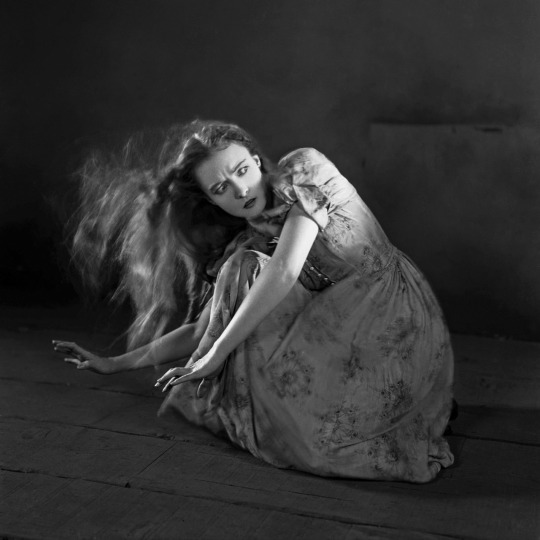
Lillian Gish as "Letty” in The Wind, 1927
#lillian gish#1920s#old hollywood#silent era#classic movies#the wind 1927#vintage#silent film#silent movies#golden age of hollywood#vintage fashion#1920s fashion#black and white#photography#photo restoration#horror
1K notes
·
View notes
Text

Children Playing in the Snow under Plum Trees in Bloom (Secchū baisō gunji yūgi zu) - woodblock print by Yoshu (Hashimoto) Chikanobu
32 notes
·
View notes
Text

Teal day dress, 1824.
Chapeau de gros de Naples, orné de plumes d'Autruche; Robe de marceline, garnie en crevés de satin
Hat made of gros de Naples, decorated with ostrich feathers; Marceline dress, trimmed with satin slashes.
My scan with the writing intact was unfortunately not as high quality as the torn one, but I have still transcribed and translated the text.
Gros de Naples is a plain weave silk from Italy.
#historical fashion#fashion plates#women's fashion#year: 1824#decade: 1820s#century: 1800s#19th century#nationality: french#publication: costume parisien#dress#day wear#day dress#gown#clothing#teal#blue#hat#bonnet#accessories#era: georgian#era: late georgian#era: regency#regency (unofficial)#era: bourbon restoration#op's favourites#colour illustration
9 notes
·
View notes
Photo

ca. 1828 Paulína von Lebzeltern by Konstantin Danil (Galéria mesta Bratislavy - Bratislava-Staré Mesto, Slovakia). From tumblr.com/history-of-fashion, Her bodice has fan-like pleats.
#1820s fashion#Romantic era fashion#Biedermeier fashion#French Restoration fashion#Paulína von Lebzeltern#Konstantin Danil#large curl coiffure#knotted bun#off-shoulder straight neckline#belt#wrap
90 notes
·
View notes
Text









“T-Thy words of meaningless rubbish do little to alleviate the visions I am forced to endure..”
A stimboard of the Victorian Child for anon!
🖤-🖤-🖤
🕯️-x - 🕯️
🖤-🖤-🖤
#stimblr#stimboard#stim#stimmy#stim board#stim gif#stim gifs#writing#fashion#Victorian#victorian era#tea#rococo#painting#painting restoration#black#white#tan#brown#winning the tournament#WtG#victorian child
0 notes
Text
Some Chinese fashion styles
Disclaimer: The following styles and their definitions were observed by me and are not authoritative. I am only familiar with Hanfu and if I made mistakes and picked the wrong photo examples or fraud shops, please let me know. Also, this post focused on women's fashion because 1. I am not into men's fashion so I don't know much about them. 2. The algorithm also knew that so I don't really see them.
汉服/Hànfú
传统服饰/Chuántǒng fúshì (传服/chuán fú)
清汉女/Qīng hàn nǚ
旗装/Qí zhuāng
旗袍/Qípáo
新国风/Xīn guó fēng、新中式/Xīn zhōngshì
汉元素/hàn yuánsù
茶艺服/Cháyì fú or 茶服/chá fú
唐装/Tángzhuāng
中山装/Zhōngshānzhuāng.
汉服/Hànfú
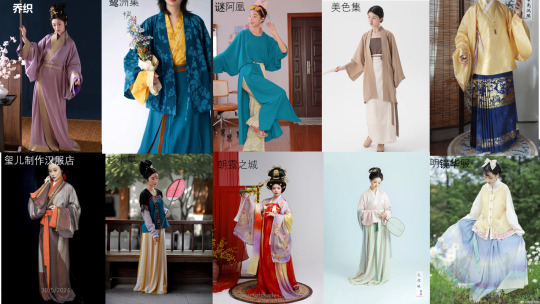
The ethnic clothing of Han Chinese (not the Han Dynasty).
There was a prohibition of Han clothing and hair styles in Qing dynasty, i.e. the 剃发易服/Tìfā yìfú qu Queue Ordinance, so modern hanfu is an on-going revivalist moment.
Modern hanfu are based on archeological evidences with minor twists to suit modern like, such as the type of fabric used and cut.
As a result, there are many types of garments and sub-styles. The figure above shows some examples.
While which style should be included and promoted is a constant debate, but in general, the cutout line is the Qing dynasty (however small accessories such as purses are alright).
传统服饰/Chuántǒng fúshì (传服/chuán fú)
No example because I am not sure who identified with this label.
The Chinese traditional clothing.
This either referred to historical clothing restorers (regardless of ethnicity) or people who promoted that the traditional clothing of Han people should be in the late Ming dynasty style, since "people should get up at where they had fallen".
They might be agreeable with the hanfu movement or not.
清汉女/Qīng hàn nǚ
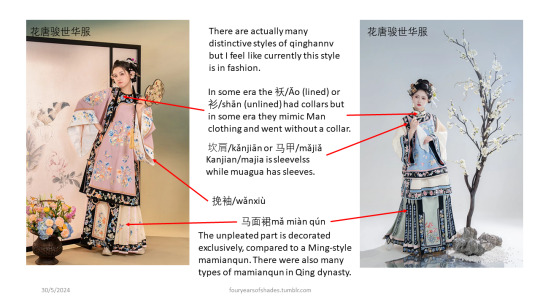
The clothing of women of Han Chinese in the Qing dynasty.
Since the Queue Ordinance wasn't that strictly enforced on Han women, the Han women clothing in the Qing dynasty had quickly absorbed Manchurian's elements while retaining the characteristic two-piece silhouette. (Manchurian women wore a one-piece robe.)
I believed it appeared around 2019 when the styles of hanfu had moved to fully embroidered surface to a more tone down brocade or weaved patterns.
旗装/Qí zhuāng

The ethnic clothing of Man people (Manchurian).
The women's clothing are generally in round collar opened on the left (youren) with straight sleeves.
The most basic item is a 衬衣/chènyī, which doesn't have vents.
However, the most common item I have seen on the street is a 氅衣/chǎng yī (probably rented), which should be worn on top of 衬衣, since they have side vents.
They usually have no standing-up collar but in some cases a fake collar could be worn.
On top of changyi they could wear a 马褂/mǎguà、坎肩/kǎnjiān、褂裥/guà jiǎn.
旗袍/Qípáo
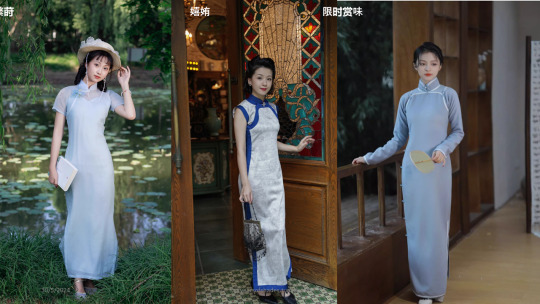
The Chinese clothing of women originated from the Minguo era, known in English as qipao or cheongsam.
The male equivalent is 长衫/chángshān.
Currently in style is the retro-cut, while uses the traditional flat cut (no shoulder seam) instead of the more body-hugging modern draping style.
There are also many variations and cuts, but the overall silhouette is similar.
新国风/Xīn guó fēng、新中式/xīn zhōngshì
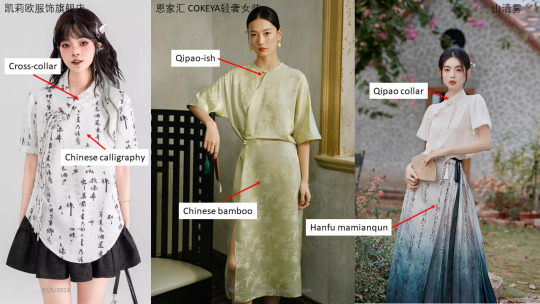
Innovative clothing that was inspired by Chinese traditional aesthetic.
It is an umbrella term.
汉元素/hàn yuánsù refers to clothing inspired by hanfu specifically, while xinguofeng could be inspired by qipao and other ethnic clothing. In addition, hanyuansu is a term more familair to hanfu-ers, so the target audience is slightly different between hanyuansu and xinguofeng.
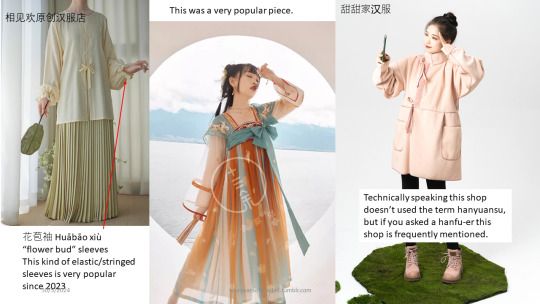
茶艺服/Cháyì fú or 茶服/chá fú,i.e tea dress, which aimed to convey a zen and rustic aesthetic could also be considered a sub-style. They are often worn by retirees, artists or workers in tea shops, calligraphy shops, Chinese spas, Chinese traditional medicine clinics etc.

The older "Chinese style" generally refers to 唐装/Tángzhuāng and 中山装/Zhōngshānzhuāng.
Tangzhuang (Tang Suit) was a men suit characterized with a mandarin collar with a row of 盘扣/pán kòu frogs in the middle. There are two pockets at the bottom front of the suit. It was a well-known looked worldwide due to the 2001 APEC summit. However, other clothes resembled a 马褂/mǎguà could also be called a tangzhuang.
Zhongshanzhuang was designed and named after Sun Yat-sen but was often known in English as the Mao Suit. Mao Suit was characterised with a 关门领/Guānmén lǐng(“closed-door collar", but also known as Mao collar in English) with a row of round buttons. There are four pockets at the front of the suit.
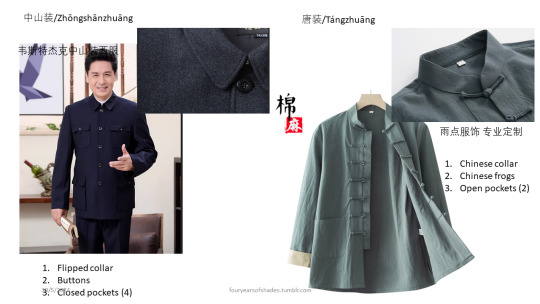
中华lolita/Zhōnghuá lolita
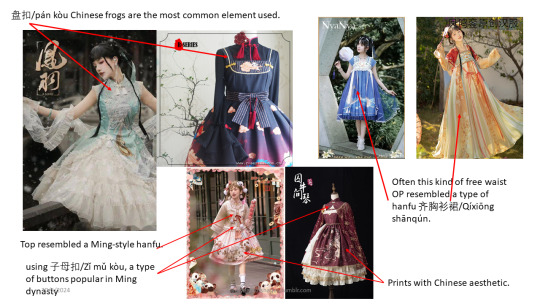
A sub-style of the lolita fashion inspired by cheongsam/qipao, hanfu or other Chinese artistic elements.
The same item could appeared in different styles, but with different cut and accessories. The following examples showed a mamianqun used in different styles.

THE END
#chinese fashion#hanfu#qinghannv#qipao#qizhuang#chinese language#non-hanfu#lolita fashion#terminology#i rarely seen men in alternate fashion#like i saw maybe one in the last year#they spent money elsewhere#like shoes#long post#reference#fouryearsofshades#i spent so much time on this post#hope you will like it#feel free to correct me if i am not right
535 notes
·
View notes
Text





























Казино Констанцы.
История казино началась в 1880 году, вскоре после возвращения Добруджанского региона Румынии(тогда оно было деревянным). В 1889 году вследствие сильной грозы, большая часть здания была уничтожена. А в 1890 году началось новое строительство Казино, однако, место расположения было немного изменено. В 1903 году деревянный павильон был признан устаревшим и не отвечающим запросам растущего города.
Строительство каменного казино началось в 1904 году. Однако, первый подрядчик работал слишком медленно, и проект здания передали французскому архитектору Даниэлю Ренару. Тот отказался от румынского традиционного стиля и занялся смешением модных в этот момент стилей. 15 августа 1910 года оно было торжественно открыто в присутствии принца Фердинанда.
Здание выполнено в архитектурном стиле "Арт Нуво". В здании были бальный зал (благодаря чему в здании могли проводиться балы, организованные властями муниципалитета), два читальных зала, две игровые комнаты и терраса у моря. Здесь в 1914 году встречали семью русского императора – одну из его дочерей(Ольгу) сватали за румынского принца. Казино работало в режиме 24/7, было хорошо охраняемо и сюда было практически невозможно попасть без разрешения. Во время первой и второй Мировых войн здание служило как госпиталь. К сожалению, оно подверглось сильным бомбовым ударам.
В советское время Казино было восстановлено и использовалось для проведения заседаний местного совета. В конце 80х было решено вернуть зданию первоначальное предназначение и переоборудовать его обратно в казино. Последний капитальный ремонт здесь был в 1988 году. Поддержание инфраструктуры казино в последние годы стало слишком дорогим, и в 1990 году здание было закрыто. Сейчас некогда великолепное здание с колоннами, мрамором и лепниной заброшено. На его восстановление нужны большие деньги, которых, к сожалению, власти Румынии пока не нашли. Но это не мешает туристам приезжать полюбоваться роскошным дворцом.
Constanta Casino.
The history of the casino began in 1880, shortly after the return of the Dobrogea region to Romania (at that time it was wooden). In 1889, due to a strong thunderstorm, most of the building was destroyed. And in 1890, a new construction of the Casino began, however, the location was slightly changed. In 1903, the wooden pavilion was considered outdated and did not meet the needs of the growing city.
The construction of the stone casino began in 1904. However, the first contractor worked too slowly, and the design of the building was given to the French architect Daniel Renard. He abandoned the traditional Romanian style and began to mix the styles that were fashionable at that time. On August 15, 1910, it was solemnly opened in the presence of Prince Ferdinand.
The building is made in the architectural style of "Art Nouveau". The building had a ballroom (which allowed the building to host balls organized by the municipal authorities), two reading rooms, two game rooms and a terrace by the sea. In 1914, the family of the Russian emperor was met here - one of his daughters (Olga) was wooed by a Romanian prince. The casino was open 24/7, was well guarded and it was almost impossible to get in without permission. During the First and Second World Wars, the building served as a hospital. Unfortunately, it was heavily bombed.
During the Soviet era, the Casino was restored and used for meetings of the local council. In the late 80s, it was decided to return the building to its original purpose and convert it back into a casino. The last major renovation was in 1988. Maintaining the casino infrastructure in recent years has become too expensive, and in 1990 the building was closed. Now the once magnificent building with columns, marble and stucco is abandoned. Its restoration requires a lot of money, which, unfortunately, the Romanian authorities have not yet found. But this does not stop tourists from coming to admire the luxurious palace.
Источник://urban3p.ru/object24142,/profhobby.ru/wallpaper/2038-009251,planetofhotels.com/guide/ru/rumyniya/konstanca,/www.blackseanews.net/read/52468,/account.travel/place/casino-constanta.html, //vk.com/wall-134187275_1627,/fishki.net/1586431-zabroshennoe-kazino-v-rumynii.html,://fotorelax.ru/zabroshennoe-kazino-na-beregu-chernogo-morya/.
#Румыния#Казино Констанцы#история#заброшенные места#Заброшенное#архитектура#Арт Нуво#Даниэль Ренар#набережная#порт#фотография#Romania#port#history#Casino Constanta#abandoned#Architecture#Daniel Renard#Art Nouveau#embankment#abandonedplaces#abandonedbuilding#abandoned photography#photography#lost in time
173 notes
·
View notes
Text
[Hanfu · 漢服]Chinese Warring States period(475–221 BC) Chu (state) Hanfu Based On Chu (state) lacquer figure



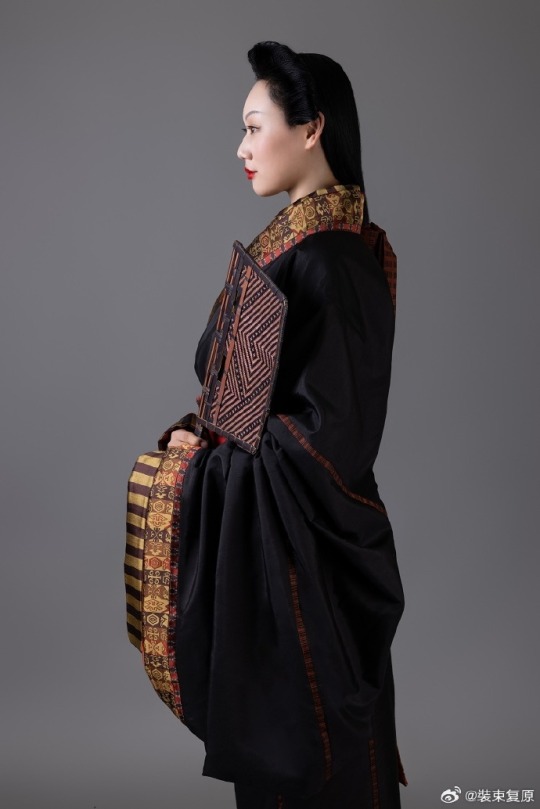
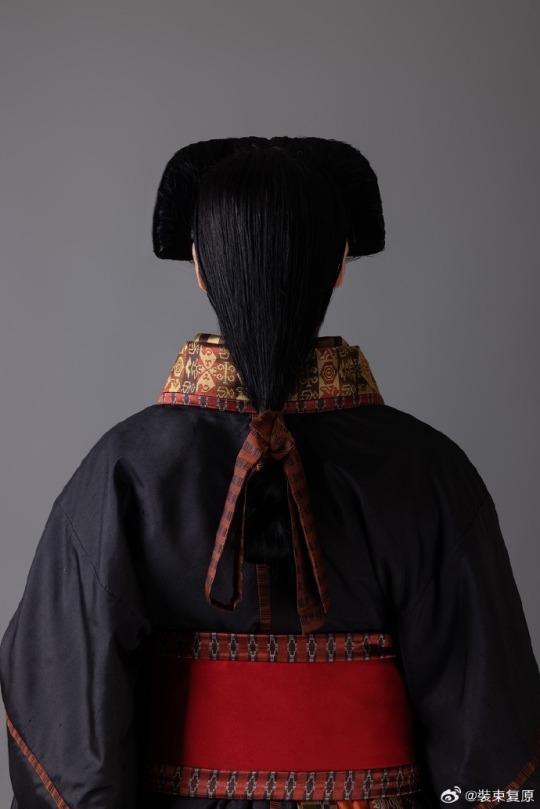
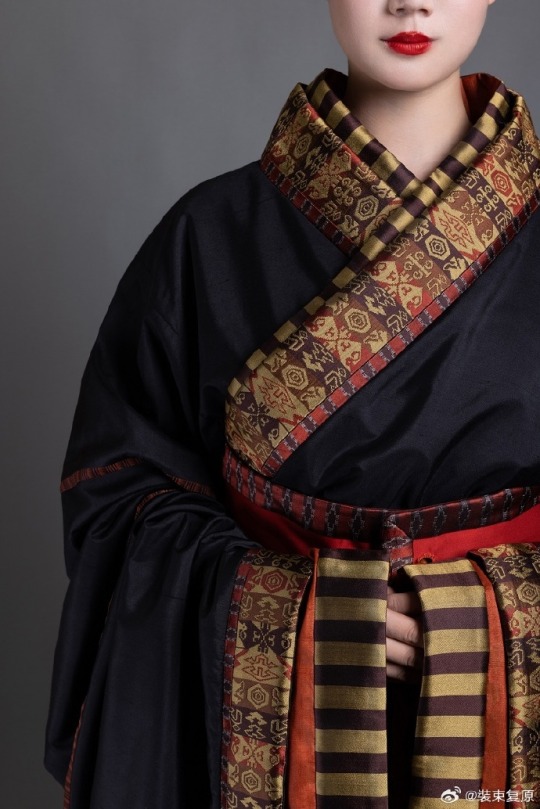
【Historical Artifact Reference】:
Lacquered wood figurines unearthed from Chu State Tomb in Shayang Tumbun Chu Tombs/沙洋塌冢楚墓出土漆俑

Collar cloth and robe unearthed from china Mashan Chu Tomb N19
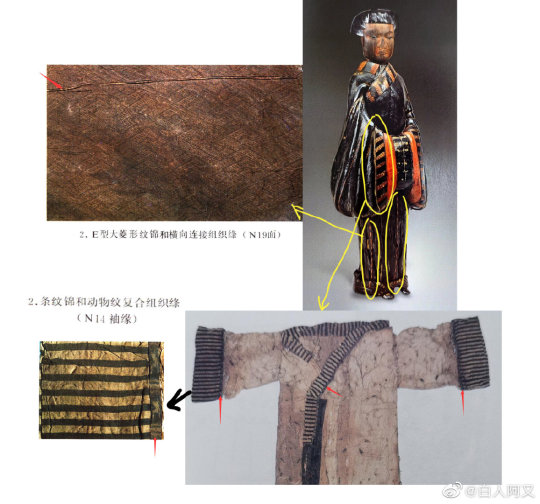
【Histoty Note】Warring States Period·Chu (state) Noble Women Fashion
Many people may wonder why this set of clothing and hairstyles are so similar to Japan, but the fact is this kind of clothing and hairstyle existed in China at least 1,000 years earlier than Japan.
During the China Warring States Period, it was popular for aristocratic men and women to wear robes.
Lacquered wood figurines and robe with similar images have been unearthed from the Shayang Tumbun Chu Tombs and the Chu Tombs at Mashan, many of which adopted the "three-dimensional structure" technique.
For example, a roughly rectangular piece is caulked at the intersection of the robe's sides, skirt sides and sleeve armpits. At the same time, the lower edge line of the top and the upper edge line of the lower skirt are incrementally extended, and then sewn into one body. It is called "Ming three-dimensional structure".
Its ingenuity is that while the outer contour of the garment remains unchanged, it effectively expands the inner space of the garment body, making it convenient for people to wrap the garment from the front to the back when wearing it, without damaging the original collar and garment forms.
The attire of aristocratic women from the Chu state in this set was restored based on the lacquered wooden figurines of the Chu tomb in Shayang. Their foreheads and temples hair are fluffy, and they have a hanging bun at the back of their heads. They wear robes that are connected up and down, and are decorated with brocade inlays at the seams.
The wearing method is the "layering method", two robes are stacked together in advance and then worn as a whole. This allows the collar edge of the lining to be show parallel to the collar edge of the outer garment, and a section of the lining to be show behind the lapel.The brocade edge is decorated with a wide belt and fixed with double belt hooks.
This "layered" wearing method shows the layers and details of Chu people's clothing, and can also show the graceful beauty of the body.
In addition, many creative clothing styles and fabric patterns emerged during the Spring and Autumn Period and the Warring States Period, bringing with them the unique atmosphere, mysterious imagination and ultimate romance of that era, becoming our inexhaustible source of art.
--------
Recreation Work by : @裝束复原
Weibo 🔗:https://weibo.com/1656910125/NhBx1oi5n
--------
#chinese hanfu#Warring States period(475–221 BC)#Chu(State)1030 BCE – 223 BCE#hanfu#hanfu accessories#hanfu_challenge#chinese traditional clothing#china#chinese#hanfu history#hanfu fashion#imperial china#chinese culture#chinese style#historical fashion#Hanfu From China#漢服#汉服#楚国
656 notes
·
View notes
Text

Chrysler Building. Gazing from Afar
Photographic Icon: The Chrysler Building has become an iconic subject for photographers, its gleaming facade and Art Deco details offering endless creative inspiration.
Artistic Muse: Artists and creatives worldwide continue to draw from the Chrysler Building's unique blend of elegance and innovation, making it a timeless muse in the worlds of art and design.
Architectural Symbolism: The spire of the Chrysler Building reaches high into the sky, symbolizing not just the ambition of the building's creators but also the aspirations of an entire era.
Elevated Gargoyles: The eagle gargoyles that adorn the 61st floor of the Chrysler Building's crown are among the highest architectural elements in New York City, adding to their mystique and symbolism.
Structural Drama: The Chrysler Building's design is a dramatic departure from traditional skyscraper aesthetics, with its setbacks and ornamentation creating a dynamic visual narrative.
Chrysler Building. Cultural Legacy
Literary Inspiration: The Chrysler Building has featured prominently in literature, serving as a backdrop for various novels and stories that capture the essence of New York City.
Film Icon: Its distinctive appearance has made the Chrysler Building a sought-after location for film and television productions, adding to its cultural prominence.
Design Evolution: The influence of the Chrysler Building's Art Deco style is visible in the design of numerous buildings, both in the United States and around the world.
Fashion Forward: Art Deco, epitomized by the Chrysler Building, has left an indelible mark on fashion, with its geometric patterns and sleek lines finding their way onto clothing and accessories.
Cultural Significance: Beyond its architectural marvel, the Chrysler Building is a symbol of the enduring spirit of innovation, aspiration, and creativity that defines New York City.
Chrysler Building. Preservation and Restoration
Ongoing Preservation: Dedicated efforts by preservationists ensure that the Chrysler Building's exquisite details and structural integrity continue to shine, safeguarding its heritage.
Art Deco Revival: The resurgence of interest in Art Deco design has brought renewed attention to the Chrysler Building's architectural significance.
Sustainability Initiatives: Modernization efforts have also extended to sustainability, with upgrades to the building's energy efficiency and environmental impact.
Visitor Experience: While the Chrysler Building is primarily a commercial office building, its lobby remains accessible to the public, allowing visitors to appreciate its Art Deco grandeur.
A Living Legacy: The Chrysler Building's legacy is not frozen in time but continues to evolve, adapting to the needs of a changing world while preserving the timeless essence of its design.
Chrysler Building. A Beacon of Hope
Iconic Beacon: The Chrysler Building's illuminated crown serves as a symbol of hope and unity, often illuminated in special colors to commemorate important events or causes.
Cultural Connection: Its presence in the New York City skyline is a source of cultural connection, a shared symbol that binds residents and visitors alike.
Historical Resilience: The Chrysler Building has withstood the test of time, remaining steadfast through historical events and shifts in cultural preferences.
Artistic Representation: Countless artists have depicted the Chrysler Building in their works, capturing its beauty and significance in various mediums.
A Promise of Tomorrow: As the sun sets behind the Chrysler Building, its illuminated crown stands as a beacon, reminding us that even in challenging times, there is always a brighter future on the horizon.
The Chrysler Building, with its timeless elegance and architectural innovation, continues to inspire and captivate. Its enduring legacy reminds us of the power of human creativity, determination, and the enduring spirit of New York City. In its gleaming spire and Art Deco splendor, we find not just a building, but a symbol of aspiration and a testament to the heights that can be achieved through bold vision and unwavering dedication.
Previous page Chrysler Building Next page
#Chrysler Building#new york city#new-york#new york#newyork#nyc#ny#urban#manhattan#city#usa#United States#buildings#travel#journey#outdoors#street#architecture#visit-new-york.tumblr.com
520 notes
·
View notes
Note
The worst opening ceremony ever
That’s because you’re looking at it all wrong. The opening ceremonies are incomparable, for a whole list of reasons:
The economic and financial situations, both in the country that’s hosting and for the entire world.
The country hosts
The creative and production teams involved in putting on the shows.
Geopolitical tensions and issues of the times
The athletes involved
You’re expecting 2008 production value in a 2024 world that’s dealing with different economic crises, two very significant wars with WW3 breakout potential, and a rising far-right/return to dictatorship. It’s incomparable.
You have to look at the opening ceremonies as their own standalone unit. And when you consider last night’s spectacle that way, it was actually a tremendous success:
Arson shut down most of the French trains and there were enormous fears of what it meant for the ceremony, but it went off without a hitch.
It rained the whole time, but all the performers still made good performances, no one was injured, and everyone made it.
Celine Dion made her first major public singing appearance while dealing with a huge medical condition. If you don’t know the significance of Celine Dion to the French or the song that she performed, then just be awed by her commitment to turn up, IN THE FREAKING RAIN, on TOP of the Eiffel Tower to perform. Who cares if she lip-synced? It was raining! She showed up anyway, with every right to demand the performance be relocated to the flat ground under cover.
The athletes all had a good time and were excited.
The cityscapes during the torch relay showed off Paris’s incredible architecture and skyline. Name any other city that can do that and have it be so meaningful.
The bells of Notre Dame rang for the first time in 5 years, they gave credit to all the workers and trades/crafts that have been restoring and repairing the cathedral, and gave an homage to the Hunchback of Notre Dame.
There was a lady in a croissant costume. A CROISSANT costume!
They had a choir of headless Marie Antoinettes accompanying a heavy metal band that was performing AT the very same prison she was held captive at.
They lit a piano on FIRE and floated it down the Seine while performing “Imagine.”
They acknowledged France’s bloody, violent history without it being preachy or sentimental. (Watch the LA 2028 ceremony ignore the US’s bloody history - I guarantee you it’ll highlight our melting pot culture but it won’t even touch on the oppression, slavery, Civil Rights era, or how indigenous peoples were treated, much like the London 2012 ceremony didn’t acknowledge Britain’s bloody history.)
They highlighted all the ways that French culture contributed to the global community; music, literature, love, fashion and Coco Chanel pink, Louis Vuitton, the Eiffel Tower, croissants, the minions, and French people’s contributions to modern sport (as well as foreign success in French sport).
The homage to Assassin’s Creed, the Phantom of the Opera, and other famous masked French figures in the torch relay and flag-bearers.
They had an opera singer dressed as the French flag singing the national anthem from a sloped rooftop over the stadium in the rain. I had literal chills, y’all. It can’t get more patriotic than that.
Organizers made statues of important French women to display during the ceremony and they’re DONATING all of them to Paris after the Olympics! I don’t know if you caught it, but the male-to-female representation in Paris’s statues is 4.5:1 (over 200 male statues, just 40ish female statues). It’s an incredible start towards gender equality in Parisian and French history that a lot of countries could take a note from.
Les Mis! Who doesn’t love a good musical interlude?! Especially one introducing a segment paying tribute to the French Revolution. (And I must admit, I’m now kinda expecting LA 2028 to have a Hamilton nod.)
The image of Assassin’s Creed with the dove wings behind her as she walked up.
All the athletes running together for the final torch relay - more chills! (Usually that doesn’t happen.)
Raising the Olympic cauldron by hot air balloon so everyone could see.
That amazing light show from the Eiffel Tower.
and so much more.
Yeah, the can-can line was sloppy and the audio quality was poor, the parade of nations took forever (they always take forever though) and no one understood the order they were coming in (because it wasn’t explained until *after* the ceremony that the upcoming hosts are also at the end) and there’s a ton people offended by the threesome and the drag queens on the grounds of religious morality (you can see my reaction to that criticism in the earlier post below), but overall, all things considered? Considering the entire 4-5 hour show, in the spectacle that is Paris, with a terrible weather forecast, in the unprecedented geopolitical times we’re in?
It was a kick-ass opening ceremony.
137 notes
·
View notes
Text





i never actually play the sims because i keep just making characters/ocs and then not wanting to mess anything up... so i made a sim for the purpose of Actually Playing the Damn Game. her name is Tourmaleena Pip and she's an alien 👽 this is her house:










all my stuff is either base game or CC; i don't have any DLC. off the top of my head, here's some of the CC i used:
CAS:
either Star Skin or Candy Shoppe Skintones; i'm not sure which one i'm using because i added them at the same time :p
Dust Alien Eyes
Hammer Horror Hair
Gun Show Fangs
Curly Antennae
Helena Eyeliner
Motel Dress
Medusa Pumps
Marigold Jumpsuit
The Cryptids Pack (sweater)
Felicity Flares & Jaclyn Scarf
Build:
The Kitchen of Tomorrow
Portland Living
Retro Walls
Retroplex Restored TV Console
Inflatable Alien
Retro Diner Sign Set
there's a bunch more floating around but those are the big ones. i also downloaded a lot of other CC from these lists that may or may not be visible in my screenshots:
Get Your Sims Grooving
70s Era Mods & Fashion
...btw, here's Tourmaleena's next-door neighbor Elliot Preston, who is (1) gay and (2) legally distinct from any historical figures:


(he's using Tropics Men's Shirt and Memphis Hair)
#what's the theme here? 50s? 70s? yes to all. the goal is obnoxious and kitschy. pant cuff width is delightfully inconsistent#shebbz shoutz#shebbz screenshotz#sims#sims 4#sims 4 cc#alien#aliencore#ts4
71 notes
·
View notes
Text

Toyohara Chikanobu
23 notes
·
View notes
Text

Men's frock coats, 1830.
Redingote de drap doublee en velours. Gilet de casimir. Pantalon de drap. Redingote de velours plain. Pantalon de drap.
Cloth frock coat lined with velvet. Cassimere vest. Cloth trousers. Plain velvet frock coat. Cloth trousers.
#fashion plates#historical fashion#19th century#century: 1800s#clothing#nationality: french#men's fashion#frock coat#coat#outerwear#day wear#suit#era: romantic#year: 1830#decade: 1830s#publication: costumes parisiens#teal#blue#green#era: georgian#era: late georgian#era: bourbon restoration#era: july monarchy#colour illustration
3 notes
·
View notes
Photo

1825 Agnes Rauch (1804-81) by Wilhelm Schadow (Hamburger Kunsthalle - Hamburg, Freie und Hansestadt Hamburg, Germany). From meisterdrucke.uk/fine-art-prints/Friedrich-Wilhelm-von-Schadow/70493/Agnes-Rauch-%281804-81%29,-1825-.html 742X1924.
#1820s fashion#Romantic era fashion#Biedermeier fashion#French Restoration fashion#Agnes Rauch#Wilhelm Schadow#straight hair#U neckline#quarter-length full sleeves#waist band#close skirt.wrap
35 notes
·
View notes
Text
a closer look at the weapons of Mt. Gelmir
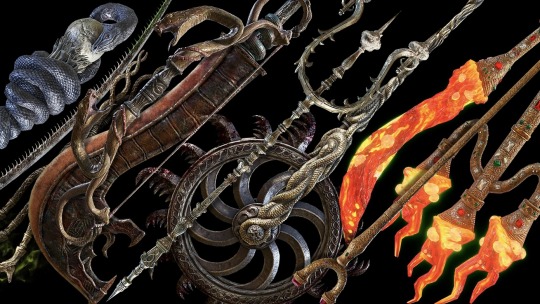
Do you ever get possessed by the uncontrollable urge to catalogue every weapon related to Mt. Gelmir, overanalyze both their visual design and their purpose, and then arrange them in a rough timeline reflecting Mt. Gelmir’s history? Because I do! There might be something wrong with me. Anyway, I ended up grouping the weapons into three main eras: the ancient cult of the great serpent, the Inquisition era under Praetor Rykard, and Rykard’s war of blasphemy against the Erdtree. This analysis became ungodly long, so I’ve put everything under a read more:
CULT OF THE GREAT SERPENT
Long before Rykard took up residence on Mt. Gelmir, the volcano was inhabited by a civilization who worshipped the Great Serpent: they practiced pagan hexes of poison and magma, and offered up blood sacrifices to their Serpent God. The weapons associated with this civilization can be identified by the following characteristics: an association with pagan magic and ritual sacrifice, dull-colored metal or wood material, and serpent imagery.
Serpent God’s Curved Sword

“Curved sword fashioned in the image of an ancient serpent deity and tool of a forgotten religion practiced on Mt. Gelmir. Formerly used to offer up sacrifices, this sword restores HP upon slaying an enemy.”
This weapon helps establish the distinct visual style of the serpent cult, since the cult is specifically referenced in the description.
Serpent Bow and Arrows

“Malformed bow in the shape of a pair of poisonous snakes. Imbues arrows with poison through pagan magic, revealing its true worth when used with poison-infused arrows. Used by assassins known as the Formless Serpents.”
“Arrow carved to resemble a flying snake. Used in tandem with the Serpent Bow. Loyal minions of the Formless Serpents, their fangs are daubed with deadly poison.”
Who are the formless serpents? Who the hell knows. But what tells me that these weapons are from the same era as the serpent cult is both the style and the mention of “pagan magic,” which brings to mind the ancient magma “hexes” that Rykard eventually rediscovered. We find the bow in the Caelid Abandoned Cave, among a hoard of ruined abductor virgins… this seems to be a case of Rykard utilizing the weapons of the serpent cult in tandem with his own modern inventions.
Serpentbone Blade
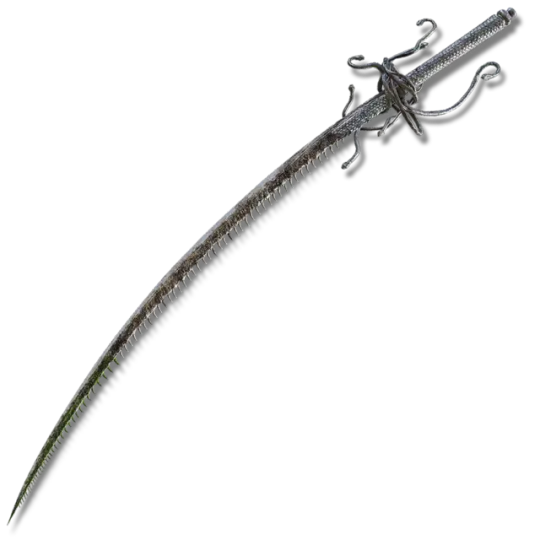
“Sinister katana modeled after a serpent bone. The densely packed row of spines that jut away from the cutting edge are coated in a lethal poison.”
A quest reward from Tanith, which implies that Volcano Manor has many of these serpent cult weapons stashed away somewhere. This weapon is likely infused with the same poison-imbuing pagan magic as the serpent bow. Notice how the hilt is decorated with coiling serpents in a dull metal color.
Devourer’s Scepter

“Scepter in the shape of a serpent devouring the world. This weapon will one day become the very symbol of the Lord of Blasphemy. A vision of the future briefly seen by Rykard in his final moments before being devoured by the great serpent.”
I believe this weapon was crafted by the serpent cult as a premonition or a prophecy of their god that they had glimpsed, which Rykard himself glimpsed in his final moments. The description says the weapon “will one day become” his symbol, implying that it had existed long before him. We also know that this weapon can’t have been made after Rykard was devoured because, since we know that Tanith was “the only human to remain by his side when he became the serpent of blasphemy,” the only ones who could’ve created the weapon are the man-serpents — and as we’ll later see, the three weapons we know they created have a uniform design that’s entirely different from the Devourer’s Scepter. Lastly, the serpent depicted on the weapon does not have Rykard’s face, while his personal sigil does depict both his and the serpent’s head.
INQUISITION ERA
Now, we skip forward in time to the weapons created under Rykard’s tenure as Praetor, during which he enforced a brutal inquisition involving the imprisonment and torture of people most likely presumed to be heretics (ironically, this inquisition in the name of the Golden Order was itself physically built upon a hotbed of ancient heresy). We can distinguish the newer weapons from the ones of the serpent cult based on a few factors: they were made to be instruments of torture, they are decorated with loopy flourishes, and there should be no serpent imagery — I don’t believe that an Inquisition of the Golden Order would be using weapons decorated with snake imagery due to their society’s view of the serpent as a “traitor to the Erdtree,” especially because the previous heretical denizens of the volcano had been crafting weapons in the serpent’s image.
Inquisitor’s Girandole
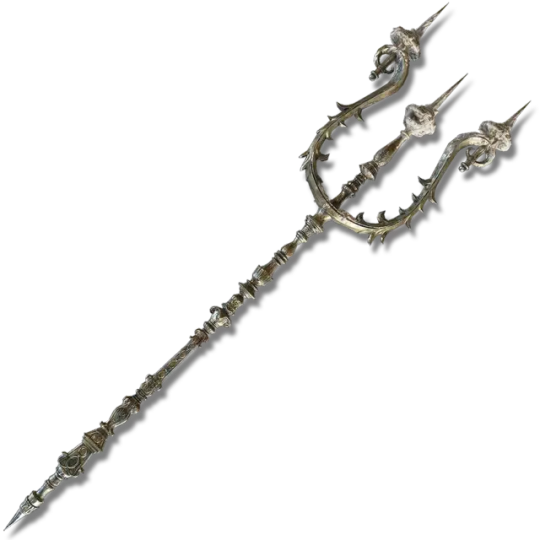
“Instrument of torture used on nobles behind the curtain at the Volcano Manor of Mt. Gelmir. Its numerous spikes pierce the flesh, then singe the wounds with flame. The smell of burnt blood induces despair in the victim. A candlestick conceived by a thorough mind.”
Unfortunately, this is really the only example of a purely inquisition-era weapon in the game, but it is immediately noteworthy that there is no snake imagery here whatsoever. The loops and flourishes are consistent with other design work we see throughout Volcano Manor, such as on the mechanized metal bridge:

Ghiza’s Wheel
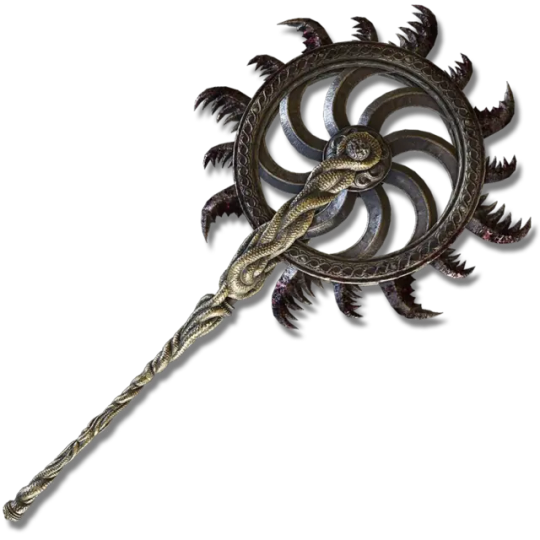
“Great iron wheel lined with flesh-flaying blades. Device of torture used by Inquisitor Ghiza. As the wheel spins it causes severe pain and blood loss. The design was adopted for use as the iconic weapon wielded by Iron Virgins.”
We know that Ghiza’s Wheel was created as a weapon of the inquisition. The wheel itself is also decorated with a loopy design, but the handle is interestingly covered in golden snakes. However, the description also reads that the design of the wheel was “adopted for use” on the iron virgins: the handle of the wheel matches the gold coiling snakes of the abductor virgins, so I propose that the special handle was added later on, when the iron virgins were likely created as machines of war for Rykard’s blasphemous crusade. Perhaps Ghiza worked on them too, and made adjustments to his wheel’s design himself?
WAR OF BLASPHEMY
When Rykard declared his treason against the Golden Order and the Erdtree, it’s likely he embraced the serpent as a symbol of his blasphemous intentions. For this reason, I theorize that Rykard only started actively using serpent imagery after his treason, which is also why we don’t see serpent imagery in the architecture and design of Volcano Manor itself.
Abductor Virgins

Looking at the abductor virgins, we see serpents throughout the design mixed with intricate swirls and flourishes, which in my opinion places their creation after Rykard's treason. We also don’t know for sure if they were created before or after Rykard fed himself to the great serpent, but I’m inclined to believe it was before: The iron maiden is a notorious real-world torture device, so it would make the most sense if Rykard’s own torturers had a hand in its creation, and we know that they had abandoned him after his devouring. It's also possible that they were altered after the fact by the man-serpents, however.

Magma Weapons of the Man-Serpents
After Rykard’s devouring and the subsequent birth of the man-serpents, we have a new subset of weapons that appear — all of these weapons make use of Rykard’s innovations in magma sorcery based on the old hexes of Mt. Gelmir. They are all made of filigreed gold and embedded with glintstone, and are created and wielded by the man-serpents.
Magma Blade
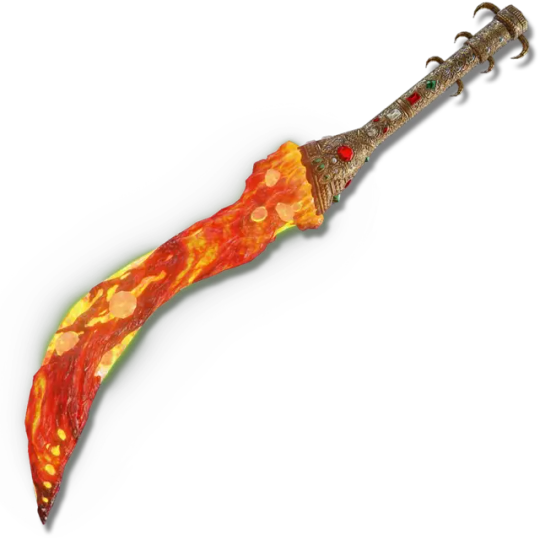
“Curved sword with a blade fashioned from the lava of Mt. Gelmir.
An armament of the man-serpents, impossible for a human to have made.”
This description implies that this trio of magic weapons must have been created by the man-serpents, which makes sense as we know that Tanith was the only human left on the Volcano Manor’s staff. The man-serpents are clearly capable of forging complicated weapons.
Gelmir Glintstone Staff
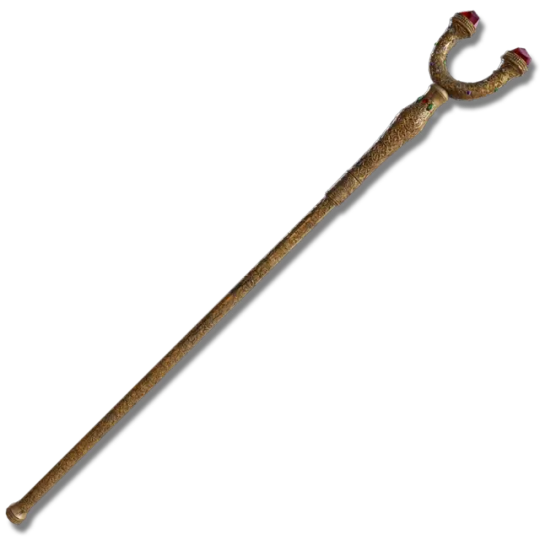
“Staff with a forked tip, embedded with red glintstones. Enhances lava sorceries. The Man-Serpents of Mt. Gelmir draw from faith in addition to intelligence to enhance the potency of their sorcery.”
Again, this description identifies this as a weapon of the man-serpents, and tells us that they are adept sorcerers who have followed in Rykard’s footsteps. The design references a serpent’s forked tongue.
Magma Whip Candlestick
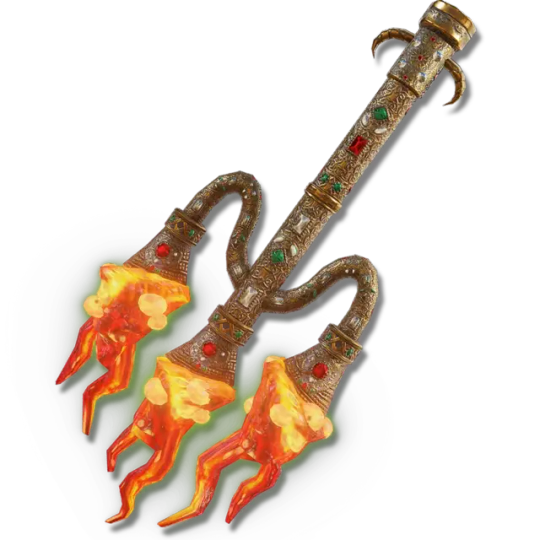
“This ritual implement is a three pronged candlestick with solid
flames formed of the magma of Mt. Gelmir.”
Volcano Manor sure loves its candles!
Man-Serpent’s Shield
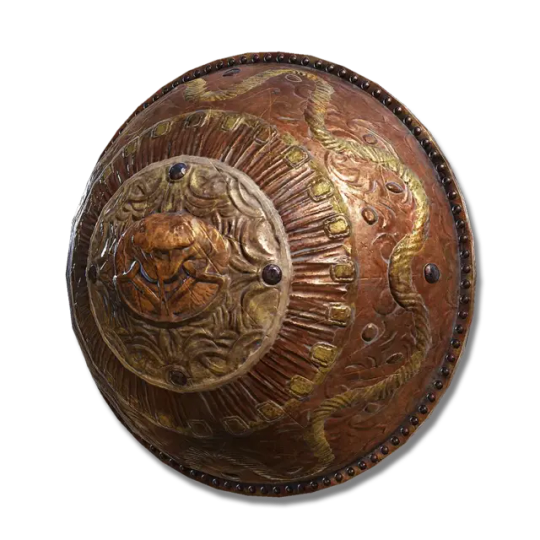
“Small copper dome-shaped roundshield carried by the man-serpents of Mt. Gelmir. Said to have been tempered in lava, it boasts great resistance to fire.”
This one isn’t technically a weapon, but it’s still worth examining. Notice the embedded gems and the bright gold snake imagery, consistent with other weapon designs of this era.
CONCLUSION
The art in this game is extremely deliberately designed, and it can tell the story beyond what just the words on the screen say. Many of the specific details are my own conjecture, but I think it’s quite clear that these weapons are consciously designed with similar features in order to place them within the game’s world and history.
#elden ring#elden ring lore#rykard#rykard lord of blasphemy#btw I didn’t include the blasphemous blade because I think it’s possible that rykard brought it with him to mt. gelmir#as opposed to creating it there#also let me know if I missed any weapons! there are so many
277 notes
·
View notes
Text









wang yibo weibo update
At the last "Revitalize Charm" exhibition area of #Chanel Fashion Manifesto# , Ms. Chanel's last collection is on display. The restored catwalk video is played at the exit, like the curtain call of her legendary life, the dialogue and fusion of two time and space, returning to the initial appearance of her style, experiencing revolution and subverting tradition, she always sticks to her original intention. Leo in the new era inherits the unremitting pursuit of simplicity, avant-garde and self-confidence.
50 notes
·
View notes